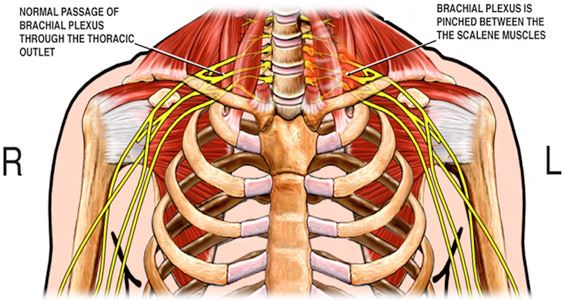Thoracic Outlet Syndrome
Thoracic Outlet Syndrome (TOS) is a term used to describe a group of disorders that occur when there is compression, injury, or irritation of the nerves and/or blood vessels (arteries and veins) in the lower neck and upper chest area. Thoracic outlet syndrome is named for the space (the thoracic outlet) between your lower neck and upper chest where this grouping of nerves and blood vessels is found. Thoracic outlet syndrome affects people of all ages and gender.

Medical Illustration Copyright © 2019 Nucleus Medical Media, All rights reserved.
Types of Thoracic Outlet Syndrome
- Neurological Thoracic Outlet Syndrome: This is the most common type of TOS. It is caused by the compression of the brachial plexus, a network of nerves that extend from the spine through the neck and into the arm. It tends to occur in people who perform repetitive overhead arm movements in their job or participate in certain sports, such as swimming or baseball.
- Venous Thoracic Outlet Syndrome: This type of TOS is caused by the compression of a subclavian vein, which carries blood from the upper extremities, to the heart. People with this condition are frequently born with a narrowing of the space where the subclavian vein extends from the shoulder to the heart. However, other activities, such as overuse of the arm and shoulder, causes the veins in the thoracic outlet to become compressed.
- Arterial Thoracic Outlet Syndrome: This type of TOS is caused by a blood clot in a subclavian artery, which carries blood from the heart to the arm. It occurs in people born with an extra cervical rib or an unusually shaped first rib, which can compress the subclavian artery and potentially lead to permanent narrowing in the artery.
Causes of Thoracic Outlet Syndrome
The disorders caused by TOS are not well understood. Yet, it is known that when the blood vessels and/or nerves in the tight passageway of the thoracic outlet are abnormally compressed, they become irritated and can cause TOS. However, other conditions, traits or habits may raise your risk for the disease. These conditions are known as risk factors and include:
Non-Modifiable Risk Factors: These factors are irreversible and cannot be changed. The more of these risk factors you have, the greater your chance of developing TOS.
- Pregnancy
Modifiable Risk Factors: These factors can be modified, treated or controlled through medications or lifestyle changes.
- Heavy weightlifting
- Poor posture
- Sports that involve repetitive arm or shoulder movement.
- Carrying heavy shoulder loads.
- Depression
Other conditions that contribute to the development of TOS:
- Anatomical defects that are present at birth.
- Bony and soft tissue abnormalities.
- Trauma from injury.
- Tumors or large lymph nodes in the upper chest or underarm area.
Symptoms of Thoracic Outlet Syndrome
Thoracic outlet syndrome symptoms can vary, depending on which structures are compressed.
When Nerves are Compressed
- Gilliatt-Sumner Hand: A condition in which muscles of the hand, particularly around the base of the thumb, atrophy or waste away.
- Numbness or tingling in your arm or fingers.
- Pain or aches in your neck, shoulder or hand.
- Weak grip
When Veins are Compressed
- Arm fatigue with activity.
- Arm pain and swelling.
- Blood clot in veins or arteries in the upper area of your body.
- Bluish color to your hand (cyanosis).
- Cold fingers, hands or arms.
- Numbness or tingling in your fingers.
- Throbbing lump near your collarbone.
- Weak or no pulse in the affected arm.
- Weakness of arm or neck.
When Arteries are Compressed
- Sudden onset of hand pain and weakness.
- Numbness and tingling in the fingers.
- Cold and pale fingers.
- Chronic arm fatigue with use.
- Non-Healing wounds or ulcerations in the fingers.
Diagnosis of Thoracic Outlet Syndrome
Diagnosing TOS can be difficult because the symptoms and their severity can vary greatly among people with the disorder. To diagnose thoracic outlet syndrome, your doctor may review your symptoms and medical history and conduct a physical examination. After that, your doctor may recommend diagnostic tests. Some of the diagnostic tests and procedures include:
- X-Rays
- Computed tomography (CT scan)
- Magnetic resonance imaging (MRI)
- Electromyography (EMG)
- Provocation tests
- Ultrasound
- Angiogram
Treatment of Thoracic Outlet Syndrome
In most cases, a conservative approach to treatment is effective, especially if your condition is diagnosed early. Best results come from a combination of medical treatment and physical therapy. Treatment options may include:
Lifestyle Changes
- Avoid activities that worsen symptoms.
- Avoid carrying heavy bags over your shoulder.
- If you are overweight, talk to your doctor about weight-loss options.
- Maintain good posture.
- Take frequent breaks at work to move and stretch.
- Make and keep appointments to see your doctor for routine check-ups and follow-up tests.
Medications
- Thrombolytic therapy is the administration of drugs called “lytics” or “clot busters” that will help break up or dissolve blood clots.
- Anti-Inflammatory medications will help reduce inflammation and relief pain.
